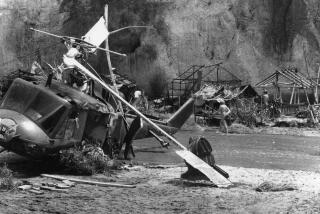Oliver Chanarin and Adam Broomberg look at a bigger picture
Reporting from Johannesburg, South Africa —
A British soldier dozes on a military flight to Helmand province, Afghanistan, beside him an ordinary brown box, like a mail parcel.
It contains a fat roll of photographic paper belonging to two artists and photographers, Oliver Chanarin and Adam Broomberg, who are “embedded” with the British forces in 2008 — traveling with the military as a photographer, camera operator or journalist, on its terms.
“We decided the only way we could be subversive in this situation was to not take photographs,” Chanarin recounts.
In a zone where people are in danger, the cardboard box is picked up by soldiers, put down, carried and treated as important, all filmed by Chanarin and Broomberg. “They [soldiers] became unwitting actors in this slightly absurdist Dadaist stunt,” said Chanarin.
On day No. 1 in Helmand, an Afghan man working as a journalist and translator for the BBC named Abdul Samad Rohani is found dead after being tortured and shot. Chanarin and Broomberg are rushed to the scene. But they do not take the expected photographs. They’ve put a sheet of photographic paper from the brown box in a jeep, the rear blackened as a darkroom. At the scene, they open the doors of the jeep for 20 seconds and close them, recording nothing more than a moment of light.
The resulting abstract image — beautiful, haunting, obtuse — can’t be decoded as a record of violence and human suffering without an explanation from Chanarin and Broomberg. It’s part of a series titled “The Day Nobody Died,” included in an exhibition of their work at the Goodman Gallery here that seeks to challenge the very nature of documentary photography. The images are displayed with the film of the box and its journey, also titled “The Day Nobody Died.”
“We actually carried a camera with us as a decoy but deleted the images at the end of each day. Some soldiers were concerned that we were not documenting the usual things, while others became quite intrigued by the box. Some even named it — like a character,” Chanarin recounts.
Needless to say, Chanarin and Broomberg didn’t last long in the war zone.
Their journey to Afghanistan was designed to subvert the idea that war photographs present a painful truth, or that photographs can ever convey the pain and horror of human suffering. Once the military realized they weren’t doing what war photographers usually do — take photographs of war — they were shuffled briskly out of Helmand, according to Chanarin.
Chanarin describes the emotional connection between photographer and subject (often a victim of some horrific event) as “dangerous.” “It’s like this shortcut to empathy. You’ve looked at it and feel like you’ve done something.” That’s why the pair removed any photographic creativity from the Helmand series, reducing it to opening and closing a door.
One of their main criticisms is of what they call a sanitized depiction of war by embedded photojournalists: They argue that heroic photographs of American soldiers get play and attention while newspapers have largely avoided the other side of the story, dying soldiers and coffins.
Chanarin and Broomberg are also bothered by the hunger with which people consume images of horror. “Photographs of human suffering are incredibly seductive. There’s something about looking at photographs of human suffering that’s incredibly pleasurable,” says Chanarin.
They see images of suffering — an HIV positive women nursing her child, an exhausted soldier, children playing with guns, grieving women, charred human remains or a malnourished, dying child — as so clichéd that they have lost their meaning.
With a camera and video in every cellphone — and even on bombs — there are plenty of witnesses to war these days. They’re calling for “a new language in photojournalism — one that presents images that are more aware of what they fail to show; images that communicate the impossibility of representing the pain and horror of personal tragedy.”
Broomberg was born in South Africa, and Chanarin spent part of his childhood here. Both reside in London. Neither was trained as a photojournalist. Broomberg studied sociology and art history, Chanarin, philosophy and artificial intelligence. They collaborated on Colors magazine, the international quarterly presented around a theme, traveling to ghetto communities and interviewing people. They’ve worked together for more than a decade and produced six books, including “Fig.” (2007), “Trust” (2000) and “Ghetto” (2003), all of which examine the nature of documentary photography. In photographing people living in ghettos the duo felt a growing doubt about the iimplicit promise from photographer to subject, that somehow the photo would change the world. “Fig.” is a collection of more than 80 captioned images – a muddle of fact and fantasy that plays on the photojournalist’s role, traveling the world “collecting” images and “evidence,” like the colonial adventurers and collectors of earlier centuries.
Their work questions that moment of collision between the worlds — the photographer and subject — the power relationship and issues of selection, subjectivity and motive. They were invited as judges on the World Press Photo awards panel in 2007, later breaking a confidentially agreement and exposing a judging process they found disturbing, bordering on abusive.
They wrote about the process of sitting in a dim room for up to 20 hours a day, each juror clutching a button attached to a computer (originally designed for a Dutch game show) to kill or keep images in the competition.
“The twelve strong jury must endure a barrage of photographic clichés over a period of seven days and nights, in order to locate one single image, the World Press Photo of the year,” they wrote in an essay titled “Unconcerned but Not Indifferent.” “Each of us clasped a voting button in the half darkness, and as the images flashed across the screen we voted anonymously to keep it in the competition or ‘to kill it.’ … At times this feels obscene. We are asked to judge whether for example a photograph of a child suffocating to death in a mudslide is sufficiently beautiful to win a prize. On this occasion it seems not. The effect is numbing.”
Instead of changing the world, they contend, photojournalism has turned its audience into passive voyeurs.
“Do we even need to be producing these images any more?” they ask in their essay. “Do we need to be looking at them? We have enough of an image archive within our heads to be able to conjure up a representation of any manner of pleasure or horror. Does the photographic image even have a role to play any more?
” … But since we do still demand illustrations to our news, then there is a chance to make images that challenge our preconceptions, rather than regurgitate old clichés.”
More to Read
The biggest entertainment stories
Get our big stories about Hollywood, film, television, music, arts, culture and more right in your inbox as soon as they publish.
You may occasionally receive promotional content from the Los Angeles Times.










